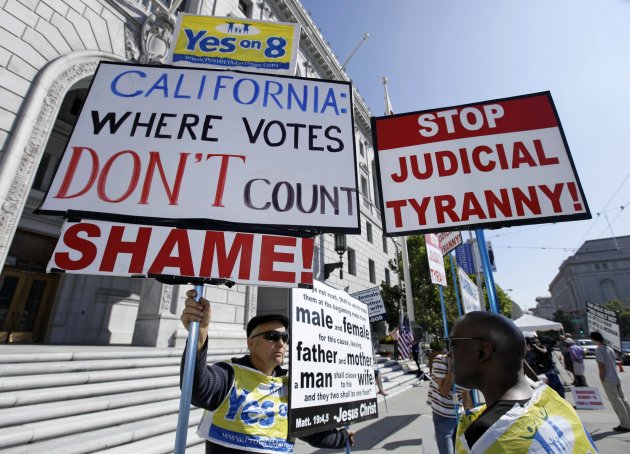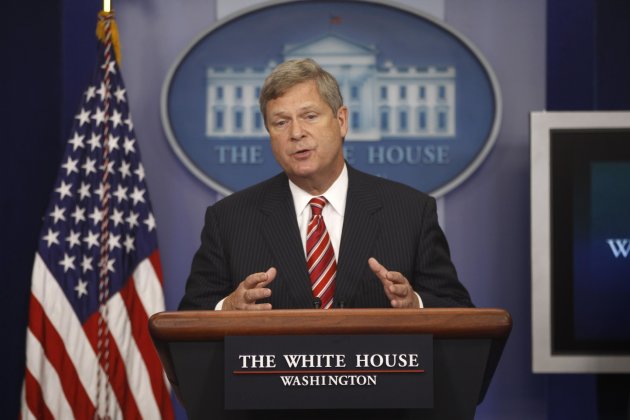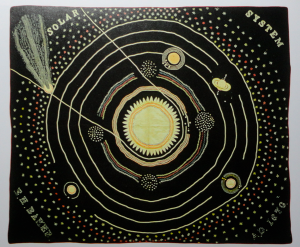 Gay marriage
Gay marriage supporters see 41 reasons to fret over the
Supreme Court's decision to take up the case of
California's ban on same-sex unions.
While nine states allow same-sex
partners to marry, or will soon, 41 states do not. Of those, 30 have
written gay marriage bans into their state constitutions.
That fact is worrisome to those who firmly believe there is a
constitutional right to marry, regardless of sexual orientation, but who
also know that the Supreme Court does not often get too far ahead of
the country on hot-button social issues.
"Mindful of history, I can't help but be concerned," said Mary Bonauto,
director of the Civil Rights Project at Gay and Lesbian Advocates and
Defenders and a leader in the state-by-state push for marriage equality.
Bonauto was speaking before the
court decided on Friday to take up cases on California's constitutional
ban on gay marriage and a federal law that denies to gay Americans who
are legally married the favorable tax treatment and a range of health
and pension benefits otherwise available to married couples.
In 2008, California voters approved the ban, Proposition 8, after the
state Supreme Court ruled that gay Californians could marry. Since
then, a federal appeals court struck down the constitutional provision,
but did not authorize the resumption of same-sex marriages pending
appeal.
Bonauto identified three earlier seminal rulings that once and for
all outlawed state-backed discrimination, and observed that in each case
the number of states that still had the discrimination on the books was
far smaller.
Thirteen states still had laws
against sodomy when the court said in 2003 that states have no right to
intrude on the private, personal conduct of people, regardless of sexual
orientation.
Interracial marriage still was illegal in 16 states in 1967 before the high court outlawed race-based state marriage bans.
In 1954, when the court issued
its landmark decision in Brown v. Board of Education, 17 states had
formally segregated school systems.
Cornell University law professor Michael Dorf said those cases illustrate a widespread misperception about the justices.
"There is a commonly held but
inaccurate view that the Supreme Court does is to impose its views on
the country. It very rarely does that. Much more frequently, it will
take a view that is either a majority in some place or a majority of
elite opinion, and speed up acceptance," said Dorf, who was a Supreme
Court law clerk to Justice Anthony Kennedy.
The forces that mounted the legal challenge to Proposition 8 have
said all along that the right to marry is so fundamental that it should
not depend on success at the ballot box or the votes of state
legislatures. Washington lawyer Theodore Olson, representing gay
Californians who wish to marry, said he will argue that there is a
"fundamental constitutional right to marry for all citizens."
But are there five justices, a majority of the court, willing to endorse that argument?
The fear among gay marriage proponents is that the court will refuse
to declare that states can no longer define marriage as the union of a
man and a woman, because to do so might provoke a backlash in public
opinion and undermine acceptance of its authority.
A high court loss for gay marriage advocates would prevent same-sex
marriages in the nation's largest state. It would not affect the
District of Columbia and the nine states — Connecticut, Iowa, Maine,
Maryland, Massachusetts, New Hampshire, New York, Vermont and Washington
— where gay couples can or soon will be able to marry.
But it could push back the day
that many in the gay rights movement, looking at strong support for gay
marriage among younger Americans, see as inevitable: the Supreme Court's
endorsement of full marriage equality nationwide.
Commenting after the court's action, Bonauto said she believes the
court can uphold an appeals court ruling that struck down Proposition 8
in a way that applies to California only and "leave to a later day
questions about broader bans on committed same-sex couples marrying."
Opponents of gay marriage look to another court case, Roe v. Wade,
that they say should serve as a cautionary tale. In 1973, the court
voted 7-2 to declare that the Constitution protects a woman's right to
an abortion.
"Should the Supreme Court decide
to overturn the marriage laws of 41 states, the ruling would become even
more divisive than the court's infamous Roe v. Wade decision," said
Tony Perkins, president of the Family Research Council. "Marriage,
unlike abortion laws in the 1970s, has been incorporated into the state constitutions of 30 states. Voters in these states will not accept an activist court redefining our most fundamental social institution."
To a degree, Perkins and Bonauto get some support from one of the nine people with a say in the matter, Justice Ruth Bader Ginsburg.
In February, Ginsburg questioned
the timing of the abortion decision and suggested it may have
contributed to the ongoing bitter debate about abortion.
"It's not that the judgment was wrong, but it moved too far too fast," Ginsburg said at Columbia University.
At the time of Roe v. Wade,
abortion was legal on request in four states, allowed under limited
circumstances in about 16 others, and outlawed under nearly all
circumstances in the other states, including Texas, where the Roe case
originated.
The court could have put off
dealing with abortion while the state-by-state process evolved, she
said. Or her predecessors could have struck down just the Texas law,
which allowed abortions only to save a mother's life, without declaring a
right to privacy that legalized the procedure nationwide, Ginsburg
said.
"The court made a decision that
made every abortion law in the country invalid, even the most liberal,"
Ginsburg said. "We'll never know whether I'm right or wrong ... things
might have turned out differently if the court had been more
restrained."













 Amateur astronomer Ellen Harding Baker of Cedar County, Iowa made this
stunning solar system quilt in 1876. The quilt is now in the collection
of the Smithsonian Institution. From the Smithsoian's History Explorer:
Amateur astronomer Ellen Harding Baker of Cedar County, Iowa made this
stunning solar system quilt in 1876. The quilt is now in the collection
of the Smithsonian Institution. From the Smithsoian's History Explorer:






